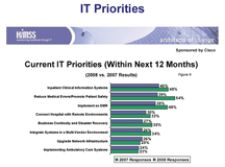
EMR comes in third on the top IT priorities list over the next 12 months. Source: 2008 HIMSS Leadership Survey.
Talk about data mining - some of the leading IT trends in healthcare and radiology were unearthed at this year’s Healthcare Information and Management Systems Society conference (HIMSS 2008). Now, as radiologists head to their next stop, the annual Society of Imaging Informatics in Medicine (SIIM) meeting, they can track those developments with ITN’s list of the Top 12 IT Trends to Watch.
Radiologists Gain Equality?: After some notable disappointments with the first-generation PACS, word on the trade show floor was that radiologists are now much more, if not equally, involved in selecting the next generation of PACS. But that issue is still up for debate, as one industry expert, Mike Cannavo, aka ‘The PACSman,’ noted, radiologists may actually be losing their leverage. As it stands today, however, the decision-making pie still divides up nicely for radiologists, with IT representing 36 percent, hospital administrators 15 percent and radiology 49 percent.
2Anywhere PACS: Because healthcare wants 24/7 access to radiology reads, Web-enabled and Web-based PACS that provide robust tools are key features for replacement PACS.
3Single is Sensible: There may soon be a meeting of the minds between radiology and cardiology as hospitals reconfigure their storage into a single repository into which radiology PACS and cardiology PACS, as well as data from other departments, will filter in and deposit clinical information. Cannavo added, “SAN players…will be the biggest area of growth in the healthcare field of medical imaging, incorporating off-site archives with disaster recovery and data migration.”
4VMware Everywhere: ‘Storage virtualization’ is said to ‘turn hardware into software.’ Sounds like alchemy? Well, VMware is the reason SAN players are getting more action. Virtualization-ware pools physical storage from multiple network storage devices into what appears to be a single storage device that is managed from a central console. Commonly used in a SAN, it helps administer backup, archiving and recovery more easily and in less time, by disguising the actual complexity of the SAN. Users can implement virtualization with software applications or by using hardware and software hybrid appliances.
5Dreams of Interoperability: The IHE’s dream that one day all disparate clinical systems will be connected – via DICOM and HL7 - is several steps closer to becoming a reality. The IHE was busy monitoring the successful interfacing of best-of-breed systems on the HIMSS show floor. But Cannavo cautions us to curb our enthusiasm with a reminder that we won’t “see this until 2010 at the soonest. Two thousand twelve or 2013 is more reasonable.”
6Analytics Alerts: Monitoring trends and extracting them from a vast repository of common data will unveil new meaning from existing patient files. As data mining shapes up into the form of ‘decision support’ or ‘evidence-based data’ at the point of care, this mechanism will help and, albeit useful, annoy radiologists. I wonder if the decision support alert takes the form of a mini-Einstein.
7DRA is a PACS Pusher: The DRA is pushing the industry toward greater efficiencies in practice management and workflow management systems. Using analytics and digital dashboards, administrators hope to improve data management by tracking performance, plus stirring up the competition amongst PACS and storage providers. Hopefully, this will drive the desired end result of better systems at lower prices. In fact, Cannavo pointed out, the DRA is said to have actually helped PACS sales because of efficiency improvements.
8Personalized Medicine: Mike Leavitt, secretary of Health and Human Services, described it as “an exciting outgrowth of our better understanding of the human genome.” Molecular diagnostics and imaging will initiate a new era of
personalized medicine where molecular biology and clinical history is used to more specifically customize patient treatments.
9Oodles of Ologies: It’s not just because it’s fun to say but ‘ologies’ have become a buzzword for connecting disparate systems enterprise-wide. Watch as radiology, cardiology, orthopedics, pathology and other departments connect their systems within a hospital. “Hospitology is next - sure beats CHINS and RHIO,” commented Cannavo.
EMR Explosion: In the spirit of the industry’s latest battle cry ‘enterprise- wide,’ the tool that will make it happen is the electronic medical record (EMR). Healthcare providers hope EMRs will improve efficiency, cut costs and produce better patient outcomes.
Who’s in the Driver’s Seat?: While many may argue that it’s the other way around, Vijay Tanjore, senior marketing manager, GE Healthcare IT, believes “in the next five years, 15-20 percent of PACS will be driven by an EMR.” This is because imaging is no longer a departmental solution but used enterprise-wide, then, like RIS data, EMR will feed into PACS. Sound like PACS blasphemy? Others counter that after investing so much in PACS, hospitals want to get their full return on investment out of the system and will drive the enterprise from their PACS. But does it matter who’s driving? “Each system feeds off the other. HIS feeds RIS, RIS feeds PACS, EMR feeds HIS and RIS and the CPR (clinical patient record),” Cannavo noted. “IT makes the decision on the CPR solution, so technically IT is the driver and we’re just Miss Daisy.”
PHR: Google, Microsoft and Revolution Health (the latest project by AOL Founder Steve Case) have bet big bucks on personal healthcare records (PHR) because they realize that patients are consumers. So why not shop for the best healthcare? Does this mean healthcare could become a commodity? Not likely. For most, survival trumps monetary cost, and with their medical records compiled neatly in their own digital vault, patients will leverage that data to get the best care and, hopefully, the best coverage, too. Some PACS developers are already using SOA (service-oriented architecture) to prepare for this transformation.


 November 29, 2025
November 29, 2025 









